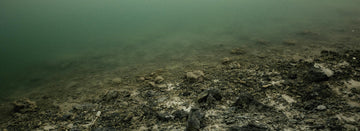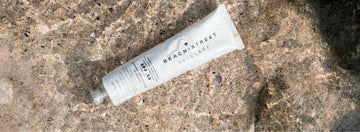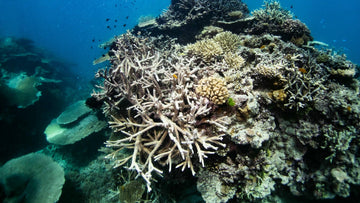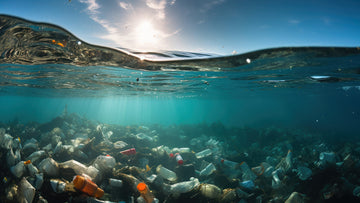In early 2025, researchers from Wageningen Marine Research published a groundbreaking study that sent a shockwave through the marine science and sustainability communities.
Their findings from Lac Bay, Bonaire, revealed the invisible truth: our oceans are absorbing the chemical traces of human activity — from sunscreens, cosmetics, plastics, and fuel residues — even in areas long considered pristine.
The report, titled “Monitoring Contaminants in Lac Bay Water Samples by Applying Passive Samplers”, confirmed that substances from personal care products, UV filters, plasticisers, and industrial compounds were detected in Bonaire’s protected waters — a UNESCO-recognized marine area that should represent one of Earth’s healthiest reef systems.
The Chemicals Detected
The research identified three key pollutants that raise particular concern:
- Octocrylene: a common UV filter used in chemical sunscreens and skincare products, known to bioaccumulate in coral tissue and interfere with photosynthesis in symbiotic algae (zooxanthellae). Previous research already linked octocrylene exposure to coral bleaching, DNA damage, and oxidative stress in marine organisms.
- Cyclotetrasiloxane (D3): a silicon-based compound widely used in personal care products, now classified in the EU as a Substance of Very High Concern (SVHC) due to its persistence, bioaccumulation, and toxicity.
- DEHP (Bis(2-ethylhexyl) phthalate) – a plasticiser commonly found in PVC materials and packaging. DEHP is a potent endocrine disruptor, affecting hormone regulation in fish and aquatic invertebrates.
While the detected concentrations in Lac Bay are below direct lethal thresholds, the research emphasizes that these compounds are bioavailable — meaning they can enter the food chain and build up in marine organisms over time.
Once absorbed by coral tissue, these chemicals are not easily broken down, posing long-term chronic stress to reef ecosystems.
A Disappearing Reef System
The broader State of Nature 2025 Report paints an even more alarming picture.
The coral cover in Bonaire has dropped below 10%, and on Saba and St. Eustatius it’s fallen below 3% — marking the reefs’ conservation status as “very unfavorable.” Scientists now warn that water quality will likely determine the fate of Caribbean coral reefs.
Unlike temperature stress from climate change, chemical stressors are locally controllable — which means that human action (or inaction) can directly influence reef survival in the coming decade.
The Biological Impact of Sunscreen Pollution
The toxic effects of chemical UV filters are well-documented in scientific literature:
- Oxybenzone and Octinoxate deform coral larvae and inhibit coral reproduction.
- Octocrylene accumulates in coral tissue, triggering mitochondrial dysfunction and oxidative damage.
- Homosalate, Avobenzone, and related compounds contribute to bioaccumulation and hormonal disruption across marine species, including fish and crustaceans.
Once in the water, these substances can persist for weeks to months, adsorbing onto sediments and being re-released with tidal motion. They do not easily degrade under sunlight and can be detected long after the tourists have gone home.
Even low concentrations — measured in parts per trillion — can cause sub-lethal stress in coral polyps and algae, reducing their resilience against bleaching events, disease, and rising sea temperatures.
Why This Matters Beyond the Caribbean
What’s happening in Bonaire is a signal to the world.
Chemical runoff and micro-pollutants are not limited to small islands; they are now found in marine ecosystems from the Mediterranean to the Pacific, from coastal Indonesia to the Great Barrier Reef.
Tourism, daily skincare routines, and industrial waste have combined to form a chemical fingerprint in the ocean that transcends borders. The ocean connects us all — and what we apply on our skin in one country can affect coral reefs on the other side of the world.
What Needs to Happen Now
Protecting the ocean from chemical pollution is both a scientific and moral imperative.
The Wageningen report underscores three urgent actions needed globally:
- Stronger Monitoring & Regulation
- Governments and environmental agencies must implement continuous chemical monitoring in coastal waters and integrate UV filters and personal care product residues into water quality legislation.
- Retailer & Brand Responsibility
- Distributors, beauty chains, and outdoor retailers must phase out chemical sunscreens and personal care products containing harmful UV filters, prioritizing reef-safe alternatives verified by independent environmental bodies.
- Consumer Awareness & Choice
- Each individual can make a measurable difference by choosing reef-safe, mineral-based sunscreens — particularly those formulated with non-nano Zinc Oxide and non-nano Titanium Dioxide, which are proven safe for coral reefs and marine life.
The Safe Alternative: Non-Nano Mineral Protection
Multiple studies (NOAA, UNEP, Environmental Toxicology & Chemistry, 2018–2023) confirm that non-nano Zinc Oxide and non-nano Titanium Dioxide do not cause coral bleaching, do not bioaccumulate, and do not release reactive oxygen species in marine environments.
They remain stable on the skin, provide broad-spectrum UV protection, and naturally settle without dissolving or harming marine organisms.
That’s why at BEACH-STREET Skincare, every formula we develop contains only non-nano mineral UV filters, free from all chemical filters, silicones, and microplastics offering sun protection that is truly safe for both people and planet.
The Time for Action Is Now
The message from the Caribbean is clear:
We cannot wait for reefs to collapse before we act.
Our oceans are reaching a tipping point — not only from climate change, but from the everyday chemicals we choose to use.
The cost of inaction will not only be measured in lost biodiversity, but in the collapse of the ecosystems that regulate our climate, feed billions, and sustain global economies.
We are all connected to the ocean — whether we live beside it or thousands of kilometers away.
Its future depends on the choices we make today.
Protect what you love. Protect the ocean. 💙
📚 References
- Wageningen Marine Research (2025). Monitoring Contaminants in Lac Bay Water Samples by Applying Passive Samplers. DOI: 10.18174/684968
- Wageningen Marine Research (2025). State of Nature 2025 – Conservation State of Coral Reefs and Communities of the Caribbean Netherlands.
- Schaap, I., & Slijkerman, D. M. E. (2018). Environmental risk assessment of three organic UV-filters at Lac Bay, Bonaire. Marine Pollution Bulletin, 135, 490–495.
- NOAA (2023). Sunscreen Chemicals and Coral Reef Health.
- UNEP (2022). Sunscreen Pollution and Marine Ecosystems Report.





